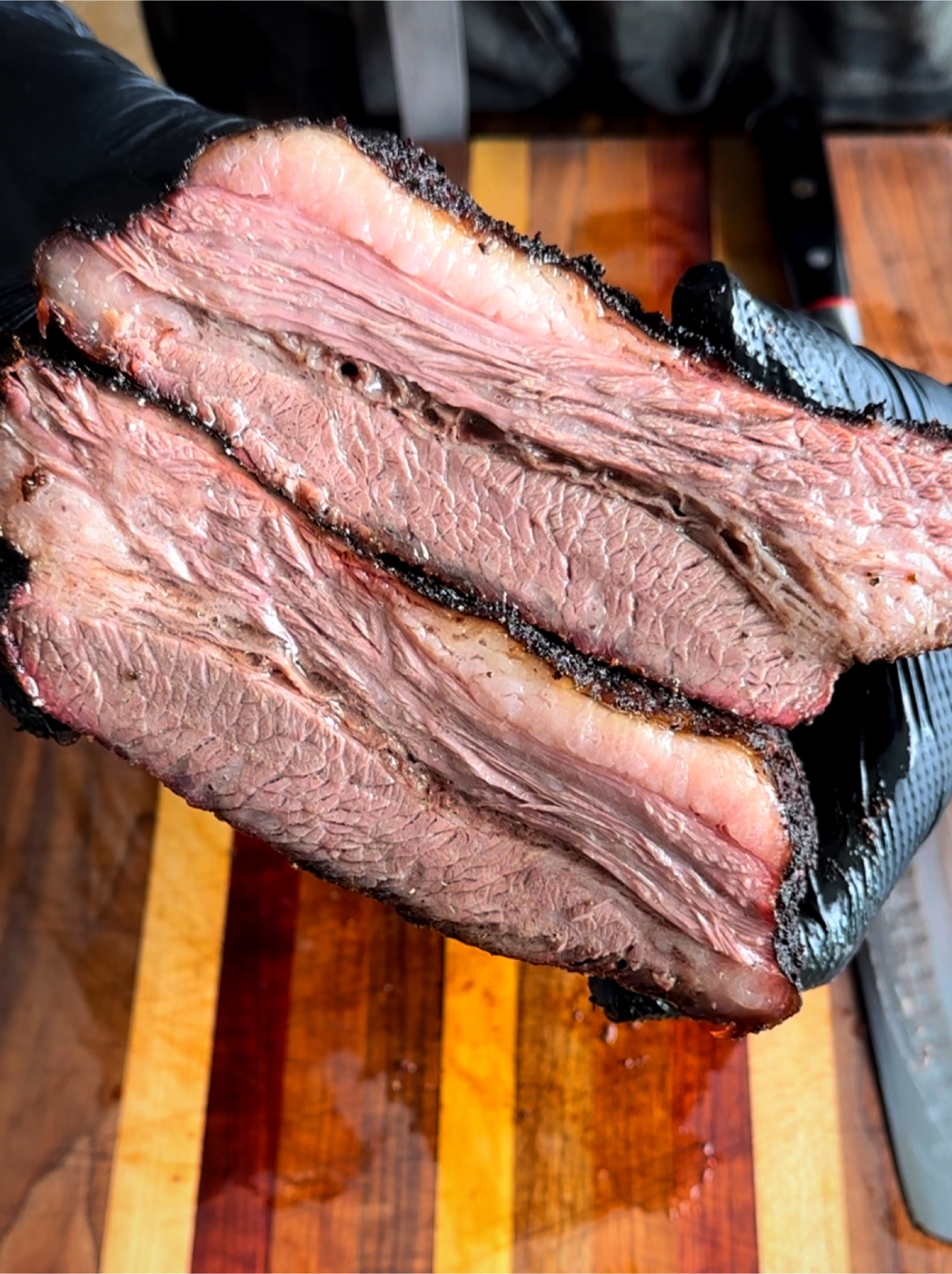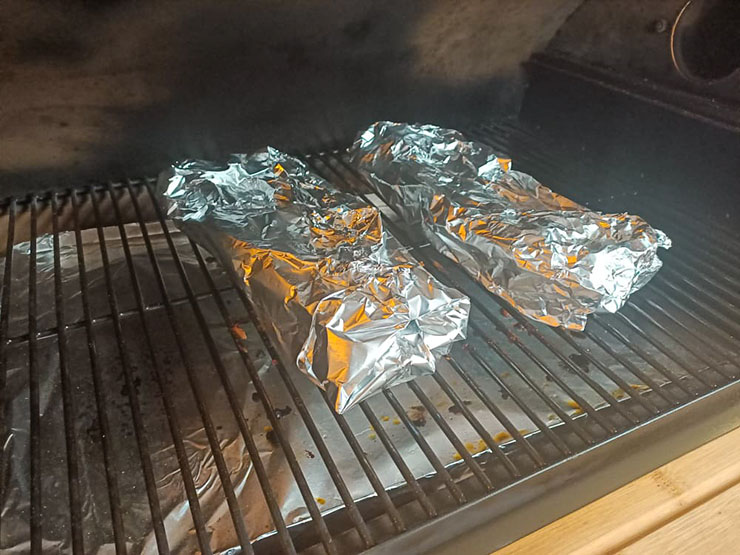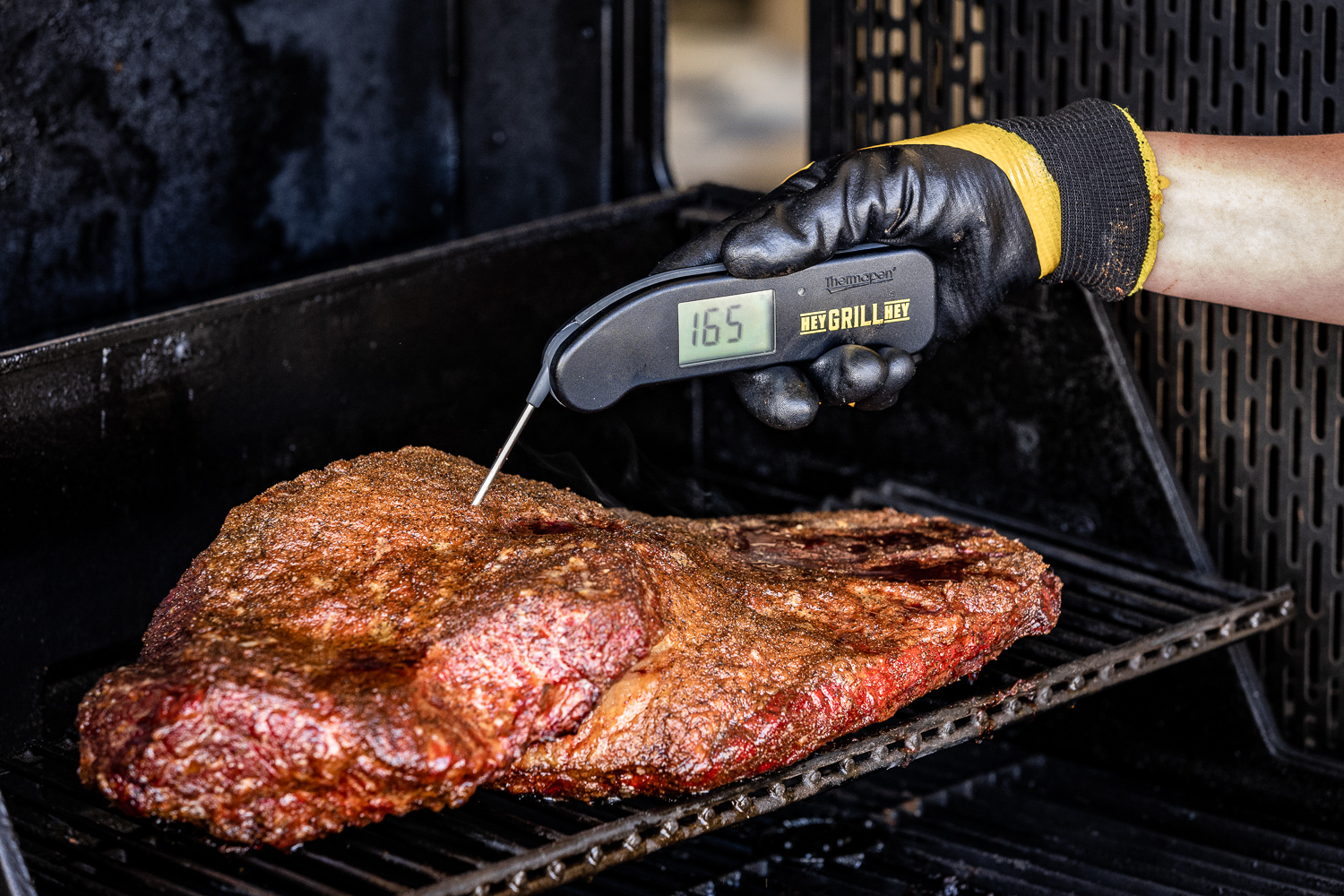
Introduction
Importance Of Wrapping Brisket In BBQ Insulation
Wrapping a brisket is an essential step in the process of BBQ cooking. It helps to retain the moisture and flavor of the meat while also aiding in the cooking process. By wrapping the brisket, you create a barrier between the meat and the surrounding air, preventing it from drying out and becoming tough.
There are two popular methods for wrapping a brisket: using butcher paper or aluminum foil. Butcher paper is a breathable material that allows some smoke and heat to penetrate while still creating a protective layer. Aluminum foil, on the other hand, provides a more airtight seal, which can help to speed up the cooking process.
Benefits Of Maintaining The Right Temperature
Maintaining the right temperature is crucial when cooking a brisket. Wrapping the brisket at the appropriate internal temperature ensures that the meat is tender and juicy. This temperature range, between 165-170°F, allows the collagen and connective tissues in the meat to break down, resulting in a more tender texture.
When the brisket is wrapped, it also helps to trap in the heat and maintain a consistent temperature throughout the cooking process. This promotes even cooking and helps to tenderize the meat more effectively. Additionally, wrapping the brisket helps to prevent the outside of the meat from becoming overcooked or burnt while the inside reaches the desired tenderness.
By wrapping the brisket, you also create a controlled environment for the meat, allowing the flavors to intensify and develop during the cooking process. This can result in a more flavorful end product that is sure to impress your guests.
In conclusion, wrapping a brisket is a crucial step in BBQ cooking. It helps to retain moisture, flavor, and tenderness while also aiding in the cooking process. By maintaining the right temperature and choosing the appropriate wrapping method, you can achieve a perfectly cooked and flavorful brisket that will be the star of your barbecue.
Understanding The Temperature Range
When it comes to wrapping a brisket, understanding the temperature range is essential. Most barbecue experts recommend wrapping the brisket when it reaches an internal temperature of 165-170 degrees Fahrenheit.
Recommended Internal Temperature For Wrapping Brisket
Why is this temperature range important? Wrapping the brisket at this stage helps to retain the moisture and flavor of the meat. The collagen and connective tissues in the brisket begin to break down at this temperature, resulting in a more tender texture.
There are two popular methods for wrapping a brisket: using butcher paper or aluminum foil. Butcher paper is a breathable material that allows some smoke and heat to penetrate while still creating a protective layer. Aluminum foil, on the other hand, provides a more airtight seal, which can help to speed up the cooking process.
Significance Of Hitting Specific Temperature Milestones
Why is it important to hit specific temperature milestones when wrapping a brisket? Wrapping the brisket at the recommended internal temperature range ensures that the meat cooks evenly and stays tender and juicy. It helps to trap in the heat and maintain a consistent temperature throughout the cooking process, preventing the outside of the meat from becoming overcooked or burnt while the inside reaches the desired tenderness.
By maintaining the right temperature and choosing the appropriate wrapping method, you can achieve a perfectly cooked and flavorful brisket that will impress your guests. Wrapping a brisket is an essential step in the BBQ cooking process, as it helps to retain moisture, flavor, and tenderness. It creates a controlled environment for the meat, allowing the flavors to intensify and develop during the cooking process.
So next time you’re cooking a brisket, make sure to monitor the internal temperature and wrap it when it reaches the recommended range. With the right temperature and wrapping method, you’ll be well on your way to cooking a delicious and tender brisket that will be the star of your barbecue.
Using A Thermometer
Why A Thermometer Is Essential For Accurate Temperature Measurement
A thermometer is an essential tool when it comes to smoking large cuts of meat like brisket. It allows you to monitor the internal temperature of the meat, ensuring that it reaches the desired doneness. By using a thermometer, you can avoid overcooking or undercooking the meat and achieve the perfect level of tenderness and juiciness.
Different Types Of Thermometers And Their Features
There are different types of thermometers available for monitoring the temperature of brisket. Each type has its own features and advantages. Here are a few popular options:
- Instant-read hand-held probe thermometer: This type of thermometer provides quick and accurate temperature readings. It is great for checking the temperature at different spots of the brisket to ensure even cooking. Look for models with Wi-Fi or Bluetooth connectivity for added convenience.
- Leave-in thermometer: A leave-in thermometer is ideal for long cooks, such as smoking a large cut of meat like a brisket. These thermometers can be inserted into the meat and left in place throughout the cooking process. Some models even have Wi-Fi or Bluetooth connectivity, allowing you to monitor the temperature remotely.
- Oven-safe dial thermometer: This type of thermometer is designed to be inserted into the meat and left in the oven throughout the cooking process. It provides a continuous temperature reading and is easy to read.
When choosing a thermometer, consider factors like accuracy, ease of use, and additional features. It’s important to follow the manufacturer’s instructions for cleaning and care to ensure accurate readings and longevity of the thermometer.
Remember, the key to cooking a perfect brisket lies in monitoring the internal temperature. By using a thermometer, you can ensure that your brisket is cooked to perfection every time.

Wrapping Options
Pros And Cons Of Wrapping Brisket In Aluminum Foil
When it comes to wrapping brisket, two popular options are aluminum foil and butcher paper. Let’s take a closer look at the pros and cons of using aluminum foil:
Pros:
- Faster cooking time: Wrapping brisket in aluminum foil can help speed up the cooking process, as it creates a steamy environment that helps to tenderize the meat more quickly.
- Moisture retention: Foil tightly seals in the moisture, preventing it from evaporating during the cooking process. This can result in a more moist and juicy brisket.
- Enhanced bark development: The steam created inside the foil can help to soften and develop a delicious bark on the surface of the brisket.
Cons:
- Limited smoke penetration: While aluminum foil retains moisture, it also acts as a barrier to smoke. This can result in less smoky flavor in the final product.
- Potential for steaming instead of smoking: The steam created inside the foil can lead to a more steamed texture rather than a smoky, barbecue-style texture.
- Less bark development: Although the foil can create a soft and flavorful bark, it may not have the same crispy texture as a brisket wrapped in butcher paper.
Advantages And Disadvantages Of Using Butcher Paper
Now let’s discuss the advantages and disadvantages of wrapping brisket in butcher paper:
Advantages:
- Smoke penetration: Unlike aluminum foil, butcher paper allows smoke to penetrate the meat, resulting in a more pronounced smoky flavor.
- Enhanced bark formation: Butcher paper creates a breathable barrier that helps to develop a crunchy bark on the outside of the brisket.
- Moisture control: Butcher paper allows some moisture to escape, preventing the meat from becoming overly steamed and maintaining a desirable texture.
Disadvantages:
- Longer cooking time: Compared to foil, butcher paper does not steam the meat as effectively, which can result in a longer cooking time.
- Limited moisture retention: While butcher paper allows some moisture to escape, it also means there is a risk of the meat drying out if not monitored carefully.
- Skill required: Wrapping brisket in butcher paper takes practice to get right. It requires proper folding techniques to ensure a tight and secure wrap.
Ultimately, the choice between aluminum foil and butcher paper comes down to personal preference and desired outcome. Both methods have their advantages and disadvantages, so it’s important to experiment and find the option that works best for you and your taste preferences.
The Texas Crutch Method
Step-by-step Guide To Wrapping Brisket In Aluminum Foil
Wrapping brisket in aluminum foil is a popular technique known as the Texas Crutch method. Follow these steps to properly wrap your brisket:
- Cook the brisket until it reaches an internal temperature of 165 degrees F.
- Remove the brisket from the heat source and place it on a large sheet of aluminum foil.
- Wrap the brisket tightly in the foil, making sure to completely seal it to prevent any moisture from escaping.
- Return the wrapped brisket to the heat source and continue cooking until it reaches your desired level of tenderness.
- Once the brisket is cooked to your liking, remove it from the heat and let it rest in the foil for at least 30 minutes to allow the juices to redistribute.
- Unwrap the brisket and slice it against the grain before serving.
Benefits Of The Texas Crutch Method
The Texas Crutch method, whether using aluminum foil or butcher paper, offers several advantages for cooking brisket:
| Advantages | Disadvantages |
|---|---|
| – Faster cooking time | – Limited smoke penetration |
| – Moisture retention | – Potential for steaming instead of smoking |
| – Enhanced bark development | – Less bark development |
| – Smoke penetration (with butcher paper) | – Longer cooking time (with butcher paper) |
| – Enhanced bark formation (with butcher paper) | – Limited moisture retention (with butcher paper) |
| – Moisture control (with butcher paper) | – Skill required (with butcher paper) |
Ultimately, the choice between aluminum foil and butcher paper for the Texas Crutch method depends on personal preference and desired outcome. Both methods have their advantages and disadvantages, so it’s important to experiment and find the option that works best for you and your taste preferences.
Using Butcher Paper
Step-by-step Instructions For Wrapping Brisket In Butcher Paper
Wrapping brisket in butcher paper is another popular method similar to the Texas Crutch. Follow these steps to properly wrap your brisket:
- Cook the brisket until it reaches an internal temperature of 165 degrees F.
- Remove the brisket from the heat source and place it on a large sheet of butcher paper.
- Wrap the brisket tightly in the butcher paper, ensuring it is fully covered and sealed.
- Return the wrapped brisket to the heat source and continue cooking until it reaches your desired tenderness.
- Once cooked, let the brisket rest in the butcher paper for at least 30 minutes to allow the juices to redistribute.
- Unwrap the brisket and slice it against the grain before serving.
Advantages Of Using Butcher Paper For Insulation
Using butcher paper to wrap your brisket offers several advantages:
| Advantages | Disadvantages |
|---|---|
| – Enhanced bark formation | – Limited moisture retention |
| – Smoke penetration | – Longer cooking time |
| – Moisture control | – Skill required |
Butcher paper allows for better smoke penetration and enhances the development of a flavorful bark on the surface of the brisket. It also provides moisture control, preventing the meat from drying out. However, compared to aluminum foil, butcher paper may result in longer cooking times and requires more skill to wrap properly. Additionally, it has limited moisture retention capabilities, so it’s important to monitor the meat closely during cooking to prevent drying out.
Timing The Wrap
Determining The Right Time To Wrap The Brisket Based On Internal Temperature
To achieve the best results when wrapping your brisket, it is important to consider the internal temperature. Most barbecue experts recommend wrapping the brisket when it reaches an internal temperature of 165-170 degrees Fahrenheit. This is the point when the meat has already undergone the necessary cooking process and has developed a good amount of smoke flavor.
The Importance Of Monitoring Temperature During The Wrap
Once you have reached the ideal temperature for wrapping, it is crucial to monitor the temperature during the wrapping process. This ensures that you achieve the desired tenderness without drying out the brisket. You can use a meat thermometer to check the internal temperature and make adjustments accordingly.
When wrapping the brisket, whether in aluminum foil or butcher paper, it is essential to maintain a good seal to prevent any moisture from escaping. This helps to retain the juiciness and tenderness of the meat.
Using aluminum foil as a wrap provides excellent moisture retention, which can result in a shorter cooking time. It acts as a barrier that helps the brisket cook faster and keeps it moist, resulting in tender and juicy meat. However, wrapping in foil can create a softer bark and limit smoke penetration.
On the other hand, using butcher paper allows for better smoke penetration and enhances the development of a flavorful bark on the surface of the brisket. It also provides moisture control, preventing the meat from drying out. However, compared to aluminum foil, butcher paper may result in longer cooking times and requires more skill to wrap properly. Additionally, it has limited moisture retention capabilities, so it’s important to monitor the meat closely during cooking to prevent drying out.
In conclusion, the choice between aluminum foil and butcher paper for wrapping your brisket depends on personal preference and the desired outcome. Both methods have their advantages and disadvantages, but with proper timing and temperature monitoring, you can achieve a delicious and tender brisket that will impress your guests.

Timing The Wrap
Testing For Desired Doneness
To ensure that the brisket is cooked to the desired level of doneness, it is important to conduct a temperature test during the wrapping process. This can be done by using a meat thermometer to check the internal temperature of the brisket. The recommended temperature range for achieving the desired doneness is between 190-203 degrees Fahrenheit. Once the thermometer registers 190 degrees Fahrenheit, it is recommended to test the meat every 15 minutes until it reaches the desired internal temperature of 203 degrees.
Choosing The Right Wrapping Method
There are two common options for wrapping a brisket: aluminum foil and butcher paper. Each method has its advantages and considerations to keep in mind.
- Wrap Brisket in Foil: Aluminum foil, also known as the Texas Crutch method, is the original way of wrapping brisket. To wrap the brisket in foil, you will need two arm-length pieces of heavy-duty aluminum foil. Lay the pieces on top of each other and place the brisket on top. Wrapping the brisket in foil provides excellent moisture retention, resulting in a shorter cooking time and tender, juicy meat. However, it may create a softer bark and limit smoke penetration.
- Wrap Brisket in Butcher Paper: Butcher paper allows for better smoke penetration and enhances the development of a flavorful bark on the surface of the brisket. It also provides moisture control, preventing the meat from drying out. However, compared to aluminum foil, using butcher paper may result in longer cooking times and requires more skill to wrap properly. It is important to monitor the meat closely during cooking to prevent drying out.
In conclusion, the choice between aluminum foil and butcher paper for wrapping your brisket depends on personal preference and the desired outcome. Both methods have their advantages and considerations. It is important to test the internal temperature during the wrap and choose a wrapping method that suits your preferences and cooking style. By monitoring the temperature and achieving the desired doneness, you can ensure a delicious and tender brisket that will impress your guests.
Conclusion
Summary Of Wrapping Options And Their Benefits
When it comes to wrapping a brisket, there are two common options: aluminum foil and butcher paper. Each method has its advantages and considerations.
- Wrapping the brisket in aluminum foil, also known as the Texas Crutch method, provides excellent moisture retention, resulting in a shorter cooking time and tender, juicy meat. However, it may create a softer bark and limit smoke penetration.
- Wrapping the brisket in butcher paper allows for better smoke penetration and enhances the development of a flavorful bark on the surface of the brisket. It also provides moisture control, preventing the meat from drying out. However, using butcher paper may result in longer cooking times and requires more skill to wrap properly. It is important to monitor the meat closely during cooking to prevent drying out.
Final Tips For Achieving The Best Results When Wrapping Brisket
- Test the internal temperature: To ensure that the brisket is cooked to the desired level of doneness, use a meat thermometer to check the internal temperature. The recommended temperature range for achieving the desired doneness is between 190-203 degrees Fahrenheit.
- Timing is key: It is crucial to wrap the brisket when it reaches the desired level of smoke absorption or when it hits the stall phase, typically around 160-170°F. Wrapping too early may hinder bark formation, while wrapping too late can result in excessive moisture loss.
- Choose the right wrapping method: Consider the advantages and considerations of wrapping in aluminum foil or butcher paper. Personal preference and the desired outcome will play a role in deciding which method to use.
By following these tips and experimenting with different wrapping methods, you can achieve a delicious and tender brisket that will impress your guests. Happy cooking!
FAQ: What Temp to Wrap Brisket: BBQ Insulation Instructions
Q: Why should I wrap my brisket during the cooking process?
A: Wrapping your brisket helps to retain moisture, speed up the cooking process, and enhance the tenderness. It also helps to prevent the brisket from drying out and allows it to cook evenly.
Q: What temperature should I wrap my brisket?
A: The ideal temperature to wrap your brisket is around 160-170°F (71-77°C). This is usually achieved after a few hours of cooking, once the brisket has gone through the initial smoke phase.
Q: What are the different methods to wrap a brisket?
A: There are several methods you can use to wrap your brisket. The most common ones include using aluminum foil, butcher paper, or insulated barbecue blankets. Each method has its advantages and it ultimately comes down to personal preference.
Q: How do I wrap my brisket with aluminum foil?
A: To wrap your brisket with aluminum foil, place the cooked brisket in the center of a large piece of foil. Fold the foil over the brisket and tightly seal the edges, ensuring there are no gaps for steam to escape. The foil will create a tight, moisture-locking seal.
Q: How do I wrap my brisket with butcher paper?
A: To wrap your brisket with butcher paper, place the cooked brisket in the center of a large piece of butcher paper. Fold one edge of the paper over the brisket, tucking it underneath to create a seal. Roll the brisket over, then fold the remaining edges of the paper towards the center, creating a snug package.
Q: How do I use barbecue insulation blankets to wrap my brisket?
A: Barbecue insulation blankets are specially designed to wrap around the entire smoker, covering your brisket and retaining heat. They are typically made of heat-resistant materials like fiberglass or thermal foam. Simply wrap the blanket around your smoker, leaving enough room for ventilation, and secure it tightly.
Q: How long should I keep the brisket wrapped?
A: Once you have wrapped your brisket, you should continue cooking it until it reaches an internal temperature of around 195-205°F (90-96°C). This will ensure the meat is tender and fully cooked. The exact cooking time will vary based on the size of the brisket and the cooking temperature.
Q: Can I unwrap the brisket before it reaches the recommended internal temperature?
A: It is generally recommended to keep the brisket wrapped until it reaches the desired internal temperature. Unwrapping it too early may result in the meat drying out or not being as tender as desired. However, if you prefer a firmer bark, you can unwrap the brisket during the last hour of cooking.
Q: What is the purpose of resting the wrapped brisket?
A: Resting the wrapped brisket allows the meat to relax and reabsorb some of the juices, resulting in a more tender and flavorful final product. It is recommended to rest the brisket for at least 30 minutes before slicing and serving.
Remember, barbecue techniques may vary, so it’s always a good idea to experiment and find the method that works best for you.

We are family-owned and operated. We love to serve coffee to our community that loves to drink it! We opened in December 2017 and are always expanding and evolving. We strive to offer a relaxing and comfortable gathering place for our customers. We not only serve delicious coffee but a full breakfast and lunch menu as well. You can also order ONLINE through our website or call ahead and pick it up right at our drive-thru window! We have a wide range of delicious baked goods, sweet treats, and a gift shop coming soon! Stop in and let us serve you!!